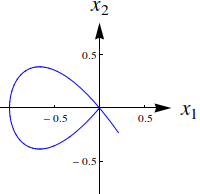Invariance of domain
Invariance of domain is a theorem in topology about homeomorphic subsets of Euclidean space [math]\displaystyle{ \R^n }[/math]. It states:
- If [math]\displaystyle{ U }[/math] is an open subset of [math]\displaystyle{ \R^n }[/math] and [math]\displaystyle{ f : U \rarr \R^n }[/math] is an injective continuous map, then [math]\displaystyle{ V := f(U) }[/math] is open in [math]\displaystyle{ \R^n }[/math] and [math]\displaystyle{ f }[/math] is a homeomorphism between [math]\displaystyle{ U }[/math] and [math]\displaystyle{ V }[/math].
The theorem and its proof are due to L. E. J. Brouwer, published in 1912.[1] The proof uses tools of algebraic topology, notably the Brouwer fixed point theorem.
Notes
The conclusion of the theorem can equivalently be formulated as: "[math]\displaystyle{ f }[/math] is an open map".
Normally, to check that [math]\displaystyle{ f }[/math] is a homeomorphism, one would have to verify that both [math]\displaystyle{ f }[/math] and its inverse function [math]\displaystyle{ f^{-1} }[/math] are continuous; the theorem says that if the domain is an open subset of [math]\displaystyle{ \R^n }[/math] and the image is also in [math]\displaystyle{ \R^n, }[/math] then continuity of [math]\displaystyle{ f^{-1} }[/math] is automatic. Furthermore, the theorem says that if two subsets [math]\displaystyle{ U }[/math] and [math]\displaystyle{ V }[/math] of [math]\displaystyle{ \R^n }[/math] are homeomorphic, and [math]\displaystyle{ U }[/math] is open, then [math]\displaystyle{ V }[/math] must be open as well. (Note that [math]\displaystyle{ V }[/math] is open as a subset of [math]\displaystyle{ \R^n, }[/math] and not just in the subspace topology. Openness of [math]\displaystyle{ V }[/math] in the subspace topology is automatic.) Both of these statements are not at all obvious and are not generally true if one leaves Euclidean space.
It is of crucial importance that both domain and image of [math]\displaystyle{ f }[/math] are contained in Euclidean space of the same dimension. Consider for instance the map [math]\displaystyle{ f : (0, 1) \to \R^2 }[/math] defined by [math]\displaystyle{ f(t) = (t, 0). }[/math] This map is injective and continuous, the domain is an open subset of [math]\displaystyle{ \R }[/math], but the image is not open in [math]\displaystyle{ \R^2. }[/math] A more extreme example is the map [math]\displaystyle{ g : (-1.1, 1) \to \R^2 }[/math] defined by [math]\displaystyle{ g(t) = \left(t^2 - 1, t^3 - t\right) }[/math] because here [math]\displaystyle{ g }[/math] is injective and continuous but does not even yield a homeomorphism onto its image.
The theorem is also not generally true in infinitely many dimensions. Consider for instance the Banach Lp space [math]\displaystyle{ \ell^{\infty} }[/math] of all bounded real sequences. Define [math]\displaystyle{ f : \ell^\infty \to \ell^\infty }[/math] as the shift [math]\displaystyle{ f\left(x_1, x_2, \ldots\right) = \left(0, x_1, x_2, \ldots\right). }[/math] Then [math]\displaystyle{ f }[/math] is injective and continuous, the domain is open in [math]\displaystyle{ \ell^{\infty} }[/math], but the image is not.
Consequences
An important consequence of the domain invariance theorem is that [math]\displaystyle{ \R^n }[/math] cannot be homeomorphic to [math]\displaystyle{ \R^m }[/math] if [math]\displaystyle{ m \neq n. }[/math] Indeed, no non-empty open subset of [math]\displaystyle{ \R^n }[/math] can be homeomorphic to any open subset of [math]\displaystyle{ \R^m }[/math] in this case.
Generalizations
The domain invariance theorem may be generalized to manifolds: if [math]\displaystyle{ M }[/math] and [math]\displaystyle{ N }[/math] are topological n-manifolds without boundary and [math]\displaystyle{ f : M \to N }[/math] is a continuous map which is locally one-to-one (meaning that every point in [math]\displaystyle{ M }[/math] has a neighborhood such that [math]\displaystyle{ f }[/math] restricted to this neighborhood is injective), then [math]\displaystyle{ f }[/math] is an open map (meaning that [math]\displaystyle{ f(U) }[/math] is open in [math]\displaystyle{ N }[/math] whenever [math]\displaystyle{ U }[/math] is an open subset of [math]\displaystyle{ M }[/math]) and a local homeomorphism.
There are also generalizations to certain types of continuous maps from a Banach space to itself.[2]
See also
- Open mapping theorem for other conditions that ensure that a given continuous map is open.
Notes
- ↑ Brouwer L.E.J. Beweis der Invarianz des [math]\displaystyle{ n }[/math]-dimensionalen Gebiets, Mathematische Annalen 71 (1912), pages 305–315; see also 72 (1912), pages 55–56
- ↑ Leray J. Topologie des espaces abstraits de M. Banach. C. R. Acad. Sci. Paris, 200 (1935) pages 1083–1093
References
- Bredon, Glen E. (1993). Topology and geometry. Graduate Texts in Mathematics. 139. Springer-Verlag. ISBN 0-387-97926-3.
- Cao Labora, Daniel (2020). "When is a continuous bijection a homeomorphism?". Amer. Math. Monthly 127 (6): 547–553. doi:10.1080/00029890.2020.1738826.
- Cartan, Henri (1945). "Méthodes modernes en topologie algébrique". Comment. Math. Helv. 18: 1–15. doi:10.1007/BF02568096. https://link.springer.com/article/10.1007%2FBF02568096.
- Deo, Satya (2018). Algebraic topology: A primer. Texts and Readings in Mathematics. 27 (Second ed.). New Delhi: Hindustan Book Agency. ISBN 978-93-86279-67-5.
- Dieudonné, Jean (1982). "8. Les théorèmes de Brouwer". Éléments d'analyse. Cahiers Scientifiques. IX. Paris: Gauthier-Villars. pp. 44–47. ISBN 2-04-011499-8.
- Hirsch, Morris W. (1988). Differential Topology. New York: Springer. ISBN 978-0-387-90148-0. (see p. 72–73 for Hirsch's proof utilizing non-existence of a differentiable retraction)
- Hilton, Peter J.; Wylie, Shaun (1960). Homology theory: An introduction to algebraic topology. New York: Cambridge University Press. ISBN 0521094224.
- Hurewicz, Witold; Wallman, Henry (1941). Dimension Theory. Princeton Mathematical Series. 4. Princeton University Press. https://archive.org/details/in.ernet.dli.2015.84609/.
- Kulpa, Władysław (1998). "Poincaré and domain invariance theorem". Acta Univ. Carolin. Math. Phys. 39 (1): 129–136. http://dml.cz/bitstream/handle/10338.dmlcz/702050/ActaCarolinae_039-1998-1_10.pdf.
- Madsen, Ib; Tornehave, Jørgen (1997). From calculus to cohomology: de Rham cohomology and characteristic classes. Cambridge University Press. ISBN 0-521-58059-5.
- Munkres, James R. (1966). Elementary differential topology. Annals of Mathematics Studies. 54 (Revised ed.). Princeton University Press.
- Spanier, Edwin H. (1966). Algebraic topology. New York-Toronto-London: McGraw-Hill.
- Tao, Terence (2011). "Brouwer's fixed point and invariance of domain theorems, and Hilbert's fifth problem". terrytao.wordpress.com. http://terrytao.wordpress.com/2011/06/13/brouwers-fixed-point-and-invariance-of-domain-theorems-and-hilberts-fifth-problem/.
External links
- Hazewinkel, Michiel, ed. (2001), "Domain invariance", Encyclopedia of Mathematics, Springer Science+Business Media B.V. / Kluwer Academic Publishers, ISBN 978-1-55608-010-4, https://www.encyclopediaofmath.org/index.php?title=Domain_invariance
 |



